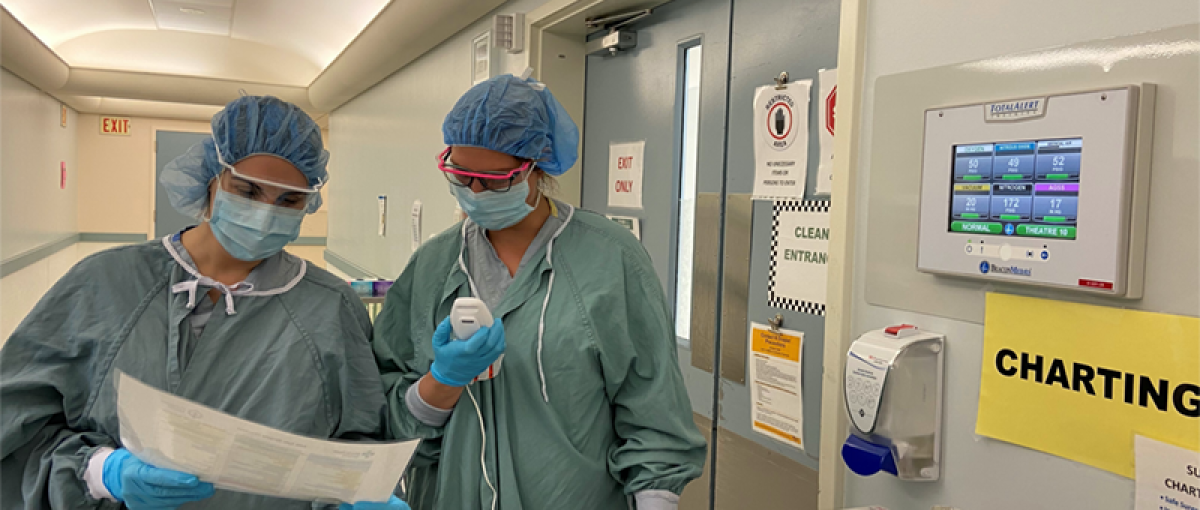Hospital staff use baby monitors to communicate
Misericordia operating room adds two-way technology to enhance safety

June 8, 2020
By Brenton Driedger, Social Media and Storytelling Advisor, Covenant Health
The surgical team operates on a broken leg for a patient who has tested positive for COVID-19. A member of the team voices a request for a piece of equipment. Moments later, the operating room door opens slightly and a colleague, clad in full protective equipment, carefully slips the requested item onto a table just inside the door and retreats back to the secure corridor. She resumes her place next to the team’s newest communication device, a baby monitor.
During the pandemic, healthcare workers are adapting to new ways of doing things, and that includes those working in hospital operating rooms. At the Misericordia Community Hospital, that means using two-way baby monitors to streamline communication.
The idea of using baby monitors came about as the Misericordia was preparing to dedicate two operating theatres to patients with presumptive or positive cases of COVID-19. During simulations, it quickly recognized communication would be a challenge.
“As you can imagine, going from a regular theatre to a COVID theatre, things slow down quite a bit,” says Carol Price, program manager. “Communication is very difficult. Everyone’s got PPE (personal protective equipment) on. They’ve got masks on. They’ve got full hoods or visors on. It’s very difficult to communicate in these circumstances.”
Keeping the operating room doors closed reduces the risk of infection for patients undergoing surgery. And when operating on patients under contact and droplet precautions such as COVID-19, reducing traffic in and out of the operating room helps minimize the risk of spreading the virus from the patient to others. In working with telecommunications partners, the Misericordia team recognized the need for a two-way communication system. And the team needed a hands-free option inside the theatre.
Telecommunications suggested using two-way baby monitors. After going through the standard approvals, the monitors were stationed outside both COVID theatres in two places: a centre core, where a runner can bring in extra supplies or equipment, and the outer hallway.
“We don’t want to open either door if we can help it,” says Carol. “Things happen, the surgical case takes a different turn and we may need different products or items, so that’s why we have a runner stationed outside those doors.”

Perioperative registered nurses Heather Raitt and Richard Mackell use the baby monitor inside the operating theatre to request supplies.
No one has to push the button on the inside because it’s a two-way monitor in the theatre. The monitors outside have a button so the runners can let their colleagues know they’re bringing supplies in or give them the go-ahead to exit the theatre to remove PPE. And by listening to what’s happening inside, the runners can proactively prepare to respond to the needs of their colleagues during the procedure.
“It’s helpful. It eliminates traffic and door opening in those theatres, and you really don’t want to unless you have to,” says Stephanie Kopas, unit manager.
The baby monitors are sanitized between cases to meet infection prevention and control protocols. And the two dedicated COVID theatres are on a separate level from the other operating room spaces.
The monitors provide an important link in the beginning and final stages of surgery. Staff must take added contact and droplet precautions when giving general anesthesia and inserting or removing a breathing tube, which are aerosol-generating medical procedures.
“One of the precautions for COVID-19 is that we have a minimal amount of staff in the room during the induction and extubation phases,” says Cheryl Holt, unit manager. “But they are also some of the most high-risk moments, so you don’t want to be left alone. The monitor provides the support you need.”
During the procedure, the runners listen in and are ready to respond to requests. And they also make sure the hallway outside is clear before staff exit the operating room and doff their PPE.
“The inside people are heavily reliant on the outside people,” says Stephanie. “They give you a little bit of information in advance, so when we’re approaching to come out of the theatre or they’re getting ready to extubate, they can give you a little bit of a play-by-play. But while the procedure is going on, it’s mostly asking for equipment and supplies.”
The two-way baby monitors have met the need for ongoing communication before, during and after a procedure. If a patient starts to decline during surgery, staff turn to their regular emergency communications and use the overhead paging system, says Carol.
Communicating through the baby monitors helps streamline other parts of the process, too. Letting the transport team members know that the surgery is coming to an end gives them time to get into their PPE and prepare to take the patient to their next destination.
Even before COVID-19, the team regularly did surgeries for patients who required contact and droplet precautions. The new monitors could be a helpful tool for future procedures, too.
“That constant communication is quite useful,” says Cheryl. “It’s just nice to have that ability to listen in on how things are going. It gives you a heads-up.”